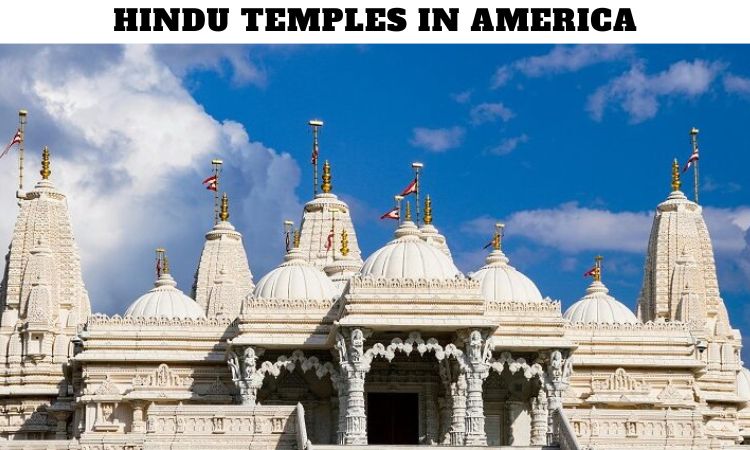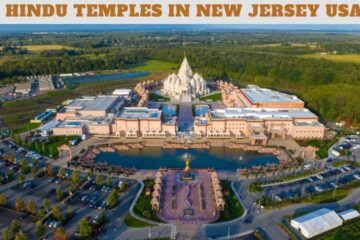
Hindu temples in America stand as powerful symbols of faith, culture, and community for the millions of Hindus who have made the United States their home. These temples are not merely places of worship; they are vibrant centers that preserve and promote Hindu traditions, values, and social connections. From humble beginnings in the mid-20th century to the magnificent structures that dot the American landscape today, the story of Hindu temples in America is a testament to the growing presence and influence of Hinduism in the Western world.
A Historical Overview
The earliest presence of Hinduism in America can be traced back to the 19th century, with the influence of Hindu scriptures and philosophy on prominent American thinkers such as Ralph Waldo Emerson and Henry David Thoreau. However, the establishment of formal Hindu institutions and temples came much later.
-
Early Influences: The transcendentalist movement of the 19th century saw American intellectuals draw inspiration from Hindu texts like the Bhagavad Gita. This philosophical engagement laid some of the groundwork for a deeper understanding of Hinduism in the West.
-
The Arrival of Swamis: The late 19th and early 20th centuries witnessed the arrival of influential Hindu spiritual leaders like Swami Vivekananda, who introduced Vedanta philosophy to the West at the World’s Parliament of Religions in Chicago in 1893. His teachings led to the establishment of the Vedanta Society, which built some of the earliest temples in the US, primarily focused on scriptural study.
-
Immigration and Temple Building: The Immigration and Nationality Act of 1965 marked a turning point, leading to a significant increase in immigration from India and other South Asian countries. This influx of Hindu immigrants created a growing need for places of worship where they could practice their faith and preserve their cultural identity. The 1970s and 1980s saw a surge in the construction of Hindu temples across the United States.
The Significance of Hindu Temples
Hindu temples in America serve a multitude of functions, both religious and cultural. They are:
-
Places of Worship: The primary function of a Hindu temple is to provide a sacred space for devotees to connect with the divine. Temples house murtis (idols) of various deities, and priests perform daily rituals, ceremonies, and pujas (prayer services).
-
Cultural Centers: Temples are important hubs for preserving and promoting Hindu culture. They often host festivals, music and dance performances, and religious discourses, providing a space for the community to come together and celebrate their heritage.
-
Community Hubs: Hindu temples play a vital role in fostering a sense of community among Hindu Americans. They offer a place for people to connect with others who share their faith and cultural background, reducing feelings of isolation and promoting social cohesion.
-
Educational Institutions: Many temples offer classes on Hindu scriptures, philosophy, yoga, and other aspects of Hindu culture. They serve as centers for learning and spiritual growth, helping to transmit knowledge to future generations.
-
Interfaith Dialogue: As Hinduism becomes more visible in America, temples also play a role in promoting interfaith understanding and dialogue. They often welcome visitors from other faiths, offering them an opportunity to learn about Hindu traditions and beliefs.
Architectural Diversity
Hindu temples in America showcase a wide range of architectural styles, reflecting the diversity of Hindu traditions and regional influences from the Indian subcontinent.
-
South Indian Style: Many temples, particularly those built in the early wave of temple construction, follow the Dravidian style of architecture, characterized by towering gopurams (gateway towers), intricate carvings, and large temple complexes. Examples include the Sri Maha Vallabha Ganapati Devasthanam in New York and the Sri Venkateswara Temple in Pennsylvania.
-
North Indian Style: Some temples reflect the Nagara style of North Indian architecture, featuring shikharas (spires) that curve upwards. The BAPS Swaminarayan Akshardham in New Jersey is a prime example of this style.
-
Syncretic Styles: Many modern temples incorporate elements from both North and South Indian styles, creating a unique blend of architectural traditions. Some temples also blend in with the local American architecture.
-
Adaptations: In some cases, existing buildings have been adapted into temples, particularly in the early stages of the community’s establishment. While these may lack the grandeur of purpose-built temples, they still serve as important places of worship and community gathering.
Prominent Hindu Temples in America
The United States is home to a large number of Hindu temples, each with its own unique characteristics and significance. Here are a few of the most prominent:
-
Sri Maha Vallabha Ganapati Devasthanam, New York: One of the oldest Hindu temples in the US, this temple is dedicated to Lord Ganesha and is known for its traditional South Indian architecture.
-
Sri Venkateswara Temple, Pennsylvania: Modeled after the famous Tirumala Venkateswara Temple in India, this temple is an important pilgrimage site for Hindus in America.
-
BAPS Swaminarayan Akshardham, New Jersey: One of the largest Hindu temples in the world, this magnificent temple complex showcases intricate carvings, stunning architecture, and a vast array of cultural exhibits.
-
Malibu Hindu Temple, California: Known for its Dravidian architecture and scenic location in the Santa Monica Mountains, this temple is dedicated to Lord Venkateswara.
-
Sri Sri Radha Krishna Temple, Utah: This temple, built by the International Society for Krishna Consciousness (ISKCON), is known for its Rajasthani-style architecture and vibrant festivals.
The Growing Influence of Hinduism in America
The increasing number of Hindu temples in America reflects the growing influence of Hinduism and the expanding presence of the Hindu American community. According to Pew Research Center, Hinduism is one of the fastest-growing religious traditions in the United States. This growth has led to a greater awareness of Hindu culture, philosophy, and practices in American society.
Hindu temples play a crucial role in this process, serving as centers for cultural exchange and education. They provide a space for Hindus to maintain their religious identity while also engaging with the broader American community. As Hinduism continues to grow in the US, Hindu temples will undoubtedly play an even more important role in shaping the religious and cultural landscape of the nation.
Challenges and the Future
Despite the growth and success of Hindu temples in America, the community also faces certain challenges:
-
Generational Differences: As the Hindu American community becomes more established, there are often differences in religious practice and cultural identity between first-generation immigrants and their American-born children. Temples play a crucial role in bridging this gap and fostering a sense of shared identity.
-
Resource Management: Maintaining and managing large temple complexes can be a significant financial undertaking. Temples rely on the support of their communities to fund their operations and programs.
-
Interfaith Relations: While Hindu temples often promote interfaith dialogue, there can sometimes be misunderstandings or misconceptions about Hinduism among those of other faiths. Temples play a key role in educating the broader community and fostering mutual respect.
Looking to the future, Hindu temples in America are poised to continue playing a vital role in the lives of Hindu Americans and in the broader American society. They will likely:
-
Evolve to meet the needs of a diverse community: Temples will continue to adapt their programs and services to meet the needs of a diverse and evolving Hindu American community, including both recent immigrants and American-born Hindus.
-
Strengthen their role in education: Temples will likely expand their educational offerings, providing more opportunities for people of all backgrounds to learn about Hindu philosophy, culture, and practices.
-
Play a greater role in social service: Many temples are already involved in charitable activities and social service projects. This role is likely to grow as temples seek to make a positive contribution to their local communities.
-
Foster interfaith understanding: As America becomes increasingly diverse, Hindu temples will play an increasingly important role in promoting interfaith dialogue and cooperation.
In conclusion, Hindu temples in America are more than just places of worship; they are dynamic centers of faith, culture, and community. They serve as a testament to the enduring power of Hinduism and its ability to adapt and thrive in a new land. As the Hindu American community continues to grow and evolve, these temples will undoubtedly play a vital role in shaping the future of Hinduism in America and its relationship with the broader American society.


